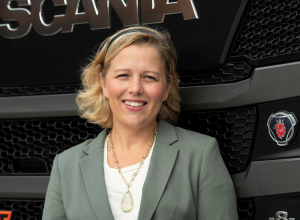 The price of the lorry is not always the most important factor in a sale. “The next question is: where can I charge? We need an answer to that too,” says Emilia Käck, public affairs manager at Scania Group, who is attending the Power Electrification Summit.
The price of the lorry is not always the most important factor in a sale. “The next question is: where can I charge? We need an answer to that too,” says Emilia Käck, public affairs manager at Scania Group, who is attending the Power Electrification Summit.
“How do we attract customers to go 100% fossil free?” is the question that will be posed at a panel discussion at the Power Electrification Summit on 9 May. The strategy conference is organised in parallel with Elfack, Northern Europe’s largest trade fair for electricity, energy and lighting.
Emilia Käck, head of community relations electrification at truck manufacturer Scania, is one of the participants at the Power Electrification Summit. The company is in the midst of a technology shift.
– We are currently in the process of switching from fossil fuels to renewables, mainly through electrification, she says. It’s no longer science fiction, it’s happening here and now. Our ambitious goal is that electric vehicles will account for 50% of our sales volume by 2030.
Setting higher standards
In terms of electrification, lorries are much more demanding than passenger cars: they are heavy vehicles that need to run for more hours per day and require larger battery packs. The biggest challenge concerns long-distance transport.
– This requires a very high power output when charging in order to comply with the rules on driving and rest time while not interfering with the flow of traffic.
This presents entangled problems related to the deployment of charging infrastructure, not just in one country but across national borders. When it comes to short-distance electrified transport, the situation is brighter:
– We already have trucks adapted for city distribution in series production. This autumn we will start production of a new series of 40 to 64 tonne vehicles for regional transport, with a range of 25 to 35 miles per charge.
Energy-efficient battery operation
Scania’s primary route towards 100% fossil-free is battery-electric trucks.
– We are also looking at hydrogen, but we believe that battery-electric operation is much more energy efficient, Emilia Käck says.
– A hydrogen vehicle requires perhaps three times as much electricity when all the conversion steps are taken into account. First, the hydrogen must be produced from electricity, using fossil-free sources of energy, then it must be converted into electricity in fuel cells to power the engine. You lose a lot of energy in that process.
She also sees a future for renewable biofuels.
– It’s an important piece of the puzzle, not least for the vehicle fleet already on the road.
Diesel is the most common fuel today.
– I don’t think it will be phased out by 2030. The pace depends on the development of the charging infrastructure, which in turn depends on the capacity of the electricity grid and the availability of fossil-free electricity. It’s a whole package. Our sustainable transport strategy is also about the connectivity of vehicles – that is, smart and safe transport, finding the best routes. That’s another kind of efficiency.
An attractive solution for customers
For truck manufacturers, it is no longer simply about selling a truck.
– Instead, we have to ask ourselves, “How do we make it attractive to our customers?” We have to help them with a solution. That’s why at Scania we have invested, through our parent company Traton, in a joint venture with Daimler and Volvo to build 1,700 public charging stations in Europe within five years.
Emilia Käck does not see a major problem in convincing drivers of the benefits of electrically operated vehicles:
– Today’s drivers of electric lorries are very positive. This is evident from our internal customer conversations and from public user studies. And that is, of course, a very good starting point!
The Power Electrification Summit, which runs in parallel with Elfack, brings together policy makers, innovators, entrepreneurs and strategists on the circular energy society of the future. Read more about the Power Electrification Summit 2023.